Network Technology, Communication and Standard : Case Study
Added on 2020-06-06
41 Pages8806 Words131 Views
Networking Technologies
1
Networking Technologies
Student's Name:
Instructor's Name:
Date:
1
Networking Technologies
Student's Name:
Instructor's Name:
Date:
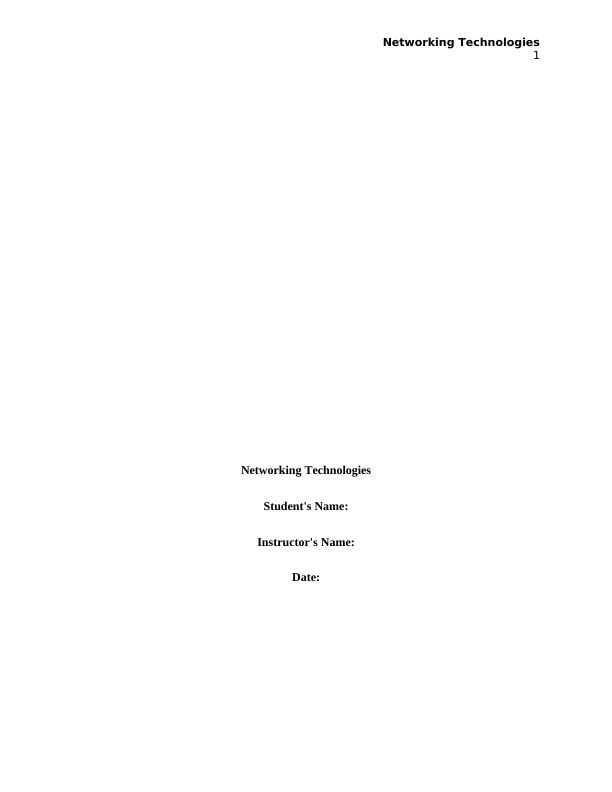
Networking Technologies
2
Contents
Task 1......................................................................................................................... 3
1.1 Discuss the benefits and constraints of different networking systems, types
and topologies. Analyse and clearly identify the requirements of the system for
this network in order to convince the management of the given case study
company.................................................................................................................. 3
Personal Area Network .................................................................................... 7
Local Area Network.......................................................................................... 7
LAN interconnecting media:............................................................................. 8
Voice over IP-................................................................................................... 8
Metropolitan Area Network.............................................................................. 9
Wide Area Network.......................................................................................... 9
Proposed Network for Beta Communication..........................................................10
1.2 Evaluate the impact of current network technology, communication and
standards for the given case study company. ......................................................15
1.3 Discuss how protocols enable the effective utilization of different networking
systems................................................................................................................. 18
Task 2....................................................................................................................... 20
2.1 Discuss the role of software and hardware components for the given company
case study. ........................................................................................................... 21
Software Requirements..................................................................................23
2.2 Discuss server types and selection requirement for the given company case
study..................................................................................................................... 25
2.3 Discuss the inter-dependence of workstation hardware with network
components........................................................................................................... 26
Task 3....................................................................................................................... 29
A high level LAN design for Beta Communication would appear as follows:..........29
................................................................................................................................. 29
Task 4....................................................................................................................... 34
4.1 Implement a network system based on the proposed design. .......................34
4.2 Test network systems to meet user requirements. .......................................37
4.3 Document and Analyse test results against expected results.........................38
.............................................................................................................................. 39
4.4 Recommend potential enhancement for the networked systems...................39
4.5 Design a maintenance schedule to support the network system....................39
References................................................................................................................ 41
2
Contents
Task 1......................................................................................................................... 3
1.1 Discuss the benefits and constraints of different networking systems, types
and topologies. Analyse and clearly identify the requirements of the system for
this network in order to convince the management of the given case study
company.................................................................................................................. 3
Personal Area Network .................................................................................... 7
Local Area Network.......................................................................................... 7
LAN interconnecting media:............................................................................. 8
Voice over IP-................................................................................................... 8
Metropolitan Area Network.............................................................................. 9
Wide Area Network.......................................................................................... 9
Proposed Network for Beta Communication..........................................................10
1.2 Evaluate the impact of current network technology, communication and
standards for the given case study company. ......................................................15
1.3 Discuss how protocols enable the effective utilization of different networking
systems................................................................................................................. 18
Task 2....................................................................................................................... 20
2.1 Discuss the role of software and hardware components for the given company
case study. ........................................................................................................... 21
Software Requirements..................................................................................23
2.2 Discuss server types and selection requirement for the given company case
study..................................................................................................................... 25
2.3 Discuss the inter-dependence of workstation hardware with network
components........................................................................................................... 26
Task 3....................................................................................................................... 29
A high level LAN design for Beta Communication would appear as follows:..........29
................................................................................................................................. 29
Task 4....................................................................................................................... 34
4.1 Implement a network system based on the proposed design. .......................34
4.2 Test network systems to meet user requirements. .......................................37
4.3 Document and Analyse test results against expected results.........................38
.............................................................................................................................. 39
4.4 Recommend potential enhancement for the networked systems...................39
4.5 Design a maintenance schedule to support the network system....................39
References................................................................................................................ 41
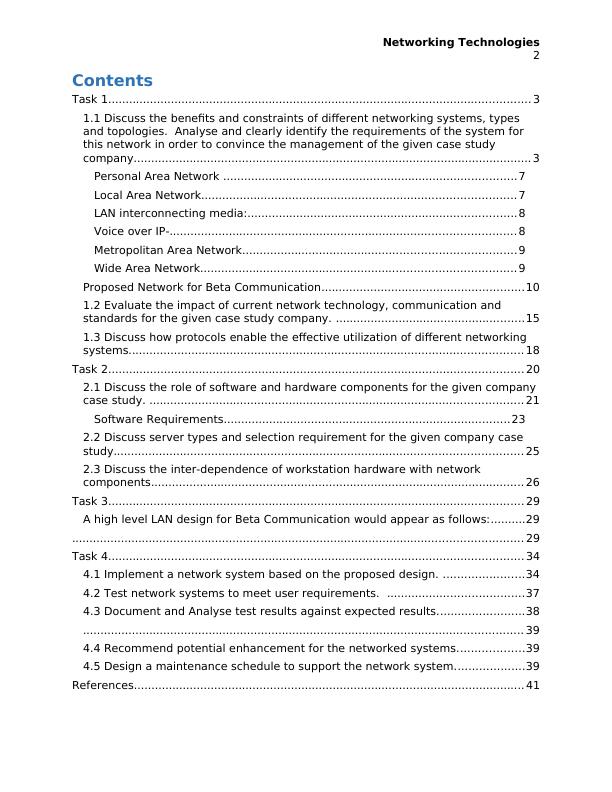
Networking Technologies
3
Task 1
1.1 Discuss the benefits and constraints of different networking systems, types and
topologies. Analyse and clearly identify the requirements of the system for this
network in order to convince the management of the given case study
company.
Computer networks can be categorized into different types. All networks are characterized based
on the type of activities carried out by a company. The actual size of a network depends on its
geographic area, the total number of computers and people who are a part of the organization’s
network. Networks can include anything like a room with a handful of computers or a million
devices spread across the world. Networks are differentiated based on its size.
Different Types of Networking Systems
Peer to Peer network is the simplest form of network. This is where two or more computers are
connected together. These computers share resources without the help of a server. The P2P
networks can have ad hoc connections, where computers transfer files through an Universal
Serial Bus. P2P networks can be both simple or complex. In the grander scale, they need special
protocols and customized applications for the communication.
Benefits of P2P
1) These networks don’t need a network operating system
2) These networks don’t need expensive servers
3) These networks are easy to setup and they don’t need specialist staff
Drawbacks of P2P
1) It is difficult to take centralized backups
2) It is not possible to organize the network centrally
3
Task 1
1.1 Discuss the benefits and constraints of different networking systems, types and
topologies. Analyse and clearly identify the requirements of the system for this
network in order to convince the management of the given case study
company.
Computer networks can be categorized into different types. All networks are characterized based
on the type of activities carried out by a company. The actual size of a network depends on its
geographic area, the total number of computers and people who are a part of the organization’s
network. Networks can include anything like a room with a handful of computers or a million
devices spread across the world. Networks are differentiated based on its size.
Different Types of Networking Systems
Peer to Peer network is the simplest form of network. This is where two or more computers are
connected together. These computers share resources without the help of a server. The P2P
networks can have ad hoc connections, where computers transfer files through an Universal
Serial Bus. P2P networks can be both simple or complex. In the grander scale, they need special
protocols and customized applications for the communication.
Benefits of P2P
1) These networks don’t need a network operating system
2) These networks don’t need expensive servers
3) These networks are easy to setup and they don’t need specialist staff
Drawbacks of P2P
1) It is difficult to take centralized backups
2) It is not possible to organize the network centrally
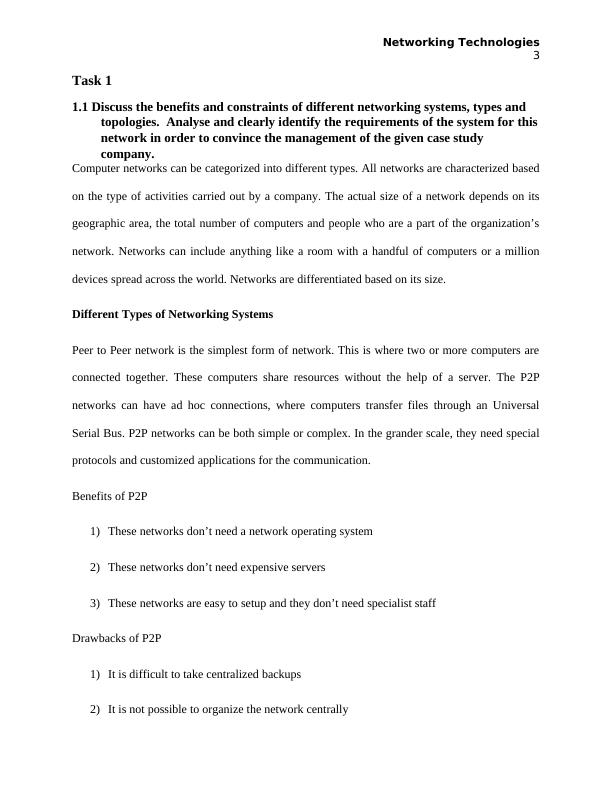
Networking Technologies
4
3) Performance issues are common
4) There are less secure
Client-Server Networks allow files to be stored in a specialized machine called the server. Data
is never stored in the hard disk of each workstation. The servers are designed to provide data to
remote clients whenever required. Indeed, Beta Communications requires a similar kind of
network. Where several clients are able to communicate, transfer files and store data centrally in
servers.
Benefits of Client-Server Networks
1) Files are stored centrally
2) Network devices can be controlled centrally
3) Backups and network security is never a problem
Drawbacks of Client-Server Networks
1) A specialized network operating system is required
2) Network peripherals can be very expensive
3) A trained network team is required
4) Network failures can be expensive and difficult to troubleshoot
Cloud Networking is a new and an upcoming concept where clients are allowed to access and
connect with devices that are located across the globe. Cloud gives clients the freedom to pay-as-
they-use. This form of networking helps all business technologies.
Benefits of cloud networking
4
3) Performance issues are common
4) There are less secure
Client-Server Networks allow files to be stored in a specialized machine called the server. Data
is never stored in the hard disk of each workstation. The servers are designed to provide data to
remote clients whenever required. Indeed, Beta Communications requires a similar kind of
network. Where several clients are able to communicate, transfer files and store data centrally in
servers.
Benefits of Client-Server Networks
1) Files are stored centrally
2) Network devices can be controlled centrally
3) Backups and network security is never a problem
Drawbacks of Client-Server Networks
1) A specialized network operating system is required
2) Network peripherals can be very expensive
3) A trained network team is required
4) Network failures can be expensive and difficult to troubleshoot
Cloud Networking is a new and an upcoming concept where clients are allowed to access and
connect with devices that are located across the globe. Cloud gives clients the freedom to pay-as-
they-use. This form of networking helps all business technologies.
Benefits of cloud networking

Networking Technologies
5
1) Cloud networks can save lots of money. They can follow zero in-house hardware
investments.
2) Cloud networks are reliable and much more consistent
3) Cloud networks offer an strategic edge to various companies
Drawbacks of cloud networking
1) With more clients, cloud service providers are likely to face greater downtimes
2) Security is always an issue with cloud computing
3) Clients or network managers have limited control over cloud networks
Virtual LAN
Virtualized networks help in cutting down the cost of network devices. These networks
are known for its agility and efficiency. Virtual networks are useful when there is plenty of CPU
intense processing and very little dependence on dedicated hardware. Web application firewalls
are ideal forms of virtualized networks.
Benefits of Virtual Networks
1) Resources can be shared easily
2) Network efficiency can be maintained
3) Virtual networks are easy to define
4) It is easy to extend virtual networks using Ethernet mode LAN s. In the longer run, Beta
Communications can shift to virtualized networks
5
1) Cloud networks can save lots of money. They can follow zero in-house hardware
investments.
2) Cloud networks are reliable and much more consistent
3) Cloud networks offer an strategic edge to various companies
Drawbacks of cloud networking
1) With more clients, cloud service providers are likely to face greater downtimes
2) Security is always an issue with cloud computing
3) Clients or network managers have limited control over cloud networks
Virtual LAN
Virtualized networks help in cutting down the cost of network devices. These networks
are known for its agility and efficiency. Virtual networks are useful when there is plenty of CPU
intense processing and very little dependence on dedicated hardware. Web application firewalls
are ideal forms of virtualized networks.
Benefits of Virtual Networks
1) Resources can be shared easily
2) Network efficiency can be maintained
3) Virtual networks are easy to define
4) It is easy to extend virtual networks using Ethernet mode LAN s. In the longer run, Beta
Communications can shift to virtualized networks

Networking Technologies
6
Types of Virtual LAN or VLAN
1. Layer 1 VLAN membership by Port:
this would be based on ports which belongs to VLAN like that of 1, 2 and 4 port this type
of LAN would not be providing mobility to the user like if they are moving somewhere else then
they would not be able to access it.
2. Layer 2 VLAN membership by MAC address:
this would be based on MAC that of the workstation all the address in this would be
interfacing into card whenever workstation is moving.
Drawbacks of Virtual Networks
1) Designing and constructing virtual networks is difficult
2) Security implementations are difficult
Clustered networks are a superset of centralized network systems. Even client-server
networks are a form of centralized networks. Here, a group of machines are connected together
with a centralized server. The server helps with storing files and handling communication. It is
possible to include as many clients as required in a clustered/centralized networking system.
Different types of network are:
1) Personal area network (PAN)
2) Local area network (LAN)
3) Metropolitan area network (MAN)
4) Wide area network (WAN)
6
Types of Virtual LAN or VLAN
1. Layer 1 VLAN membership by Port:
this would be based on ports which belongs to VLAN like that of 1, 2 and 4 port this type
of LAN would not be providing mobility to the user like if they are moving somewhere else then
they would not be able to access it.
2. Layer 2 VLAN membership by MAC address:
this would be based on MAC that of the workstation all the address in this would be
interfacing into card whenever workstation is moving.
Drawbacks of Virtual Networks
1) Designing and constructing virtual networks is difficult
2) Security implementations are difficult
Clustered networks are a superset of centralized network systems. Even client-server
networks are a form of centralized networks. Here, a group of machines are connected together
with a centralized server. The server helps with storing files and handling communication. It is
possible to include as many clients as required in a clustered/centralized networking system.
Different types of network are:
1) Personal area network (PAN)
2) Local area network (LAN)
3) Metropolitan area network (MAN)
4) Wide area network (WAN)
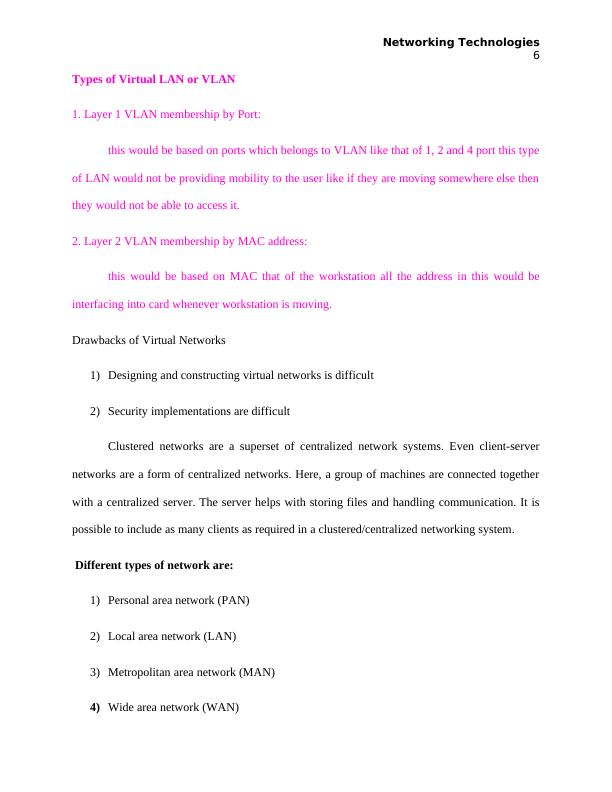
Networking Technologies
7
There are few network types for general purpose too. This includes the process of sending
files from one system to another or the internet. This includes the following:
1) Storage area network (SAN)
2) Enterprise Private Network (EPN)
3) Virtual Private Network (VPN)
Personal Area Network
Personal area network is an organized network around a particular individual. The individual is
bound within a single building. The building could be anything like his residence or office. An
ideal PAN is built using one or more peripheral devices, telephone and computers. If several
people are using the network, it is also known as home area network (HAN).
Local Area Network
Local Area Network comprises of computers in a specific site. Often, individual office
building invest on LAN. The LAN is extremely helpful in sharing printers, data storage and other
resources. LANs can be established very easily, using hardware devices like Ethernet cables,
network adapters and hubs. A very small LAN comprises of 2 machines, whereas there can be
huge LAN structures that connect numerous computers. LAN relies on wired connections that
ensure high security and speed. LANs are best used in single site applications where people need
to share resources among a known group and not the entire world.
LAN Data Communication Equipment
Switches- Repeaters- Bridges- Hubs- Routers-
This would be
allowing different
It would be
regenerating the
It would be
creating an
It would be
connecting
This would be
allowing many
7
There are few network types for general purpose too. This includes the process of sending
files from one system to another or the internet. This includes the following:
1) Storage area network (SAN)
2) Enterprise Private Network (EPN)
3) Virtual Private Network (VPN)
Personal Area Network
Personal area network is an organized network around a particular individual. The individual is
bound within a single building. The building could be anything like his residence or office. An
ideal PAN is built using one or more peripheral devices, telephone and computers. If several
people are using the network, it is also known as home area network (HAN).
Local Area Network
Local Area Network comprises of computers in a specific site. Often, individual office
building invest on LAN. The LAN is extremely helpful in sharing printers, data storage and other
resources. LANs can be established very easily, using hardware devices like Ethernet cables,
network adapters and hubs. A very small LAN comprises of 2 machines, whereas there can be
huge LAN structures that connect numerous computers. LAN relies on wired connections that
ensure high security and speed. LANs are best used in single site applications where people need
to share resources among a known group and not the entire world.
LAN Data Communication Equipment
Switches- Repeaters- Bridges- Hubs- Routers-
This would be
allowing different
It would be
regenerating the
It would be
creating an
It would be
connecting
This would be
allowing many
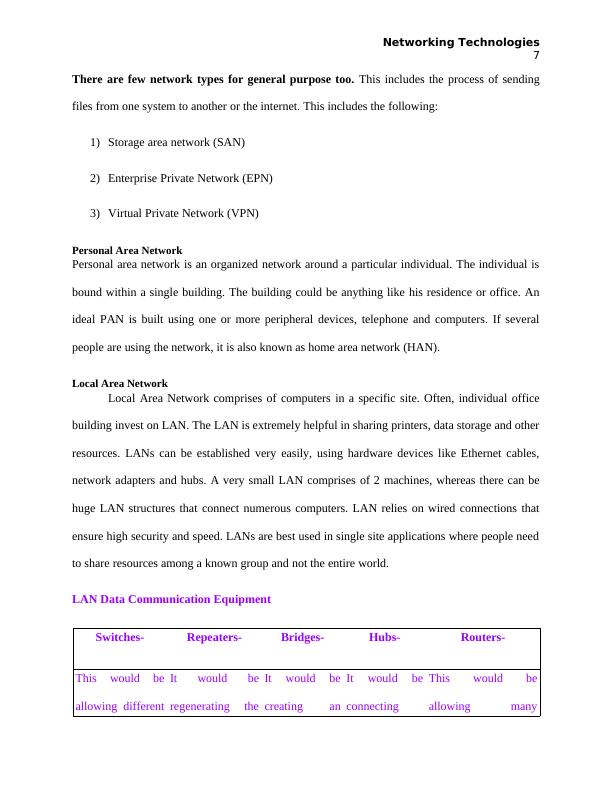
Networking Technologies
8
device on same
network to
communicate
signal over same
network if it is
corrupting or
weakening thus
this would be
extending the
signal which is
transmitted again
in network.
aggregation of
signal which is
coming from
multiple
communication
device this
would be called
to as network
bridging.
various
computer
device or other
networks
together while
it is having no
routing tables
or intelligence.
networks to
communicate with
each other.
LAN interconnecting media:
UTP STP Coaxial Fiber optic
Un-shielded media
which would be
including the twisted
pair of cables it is of
four types.
This is the shielded
twisted pair of cable
which is protecting it
from any damage or
interference.
Which is another
type of electrical
cable having its
inner conductor
surrounded by
tubular insulating
layer
It is also like electrical cable
but having more than one
optical fibers which is
carrying light
Voice over IP-
The full form would be voice over internet protocol which is helping into delivery of
voice communication and multimedia over the IP network of internet.
Video on demand-
8
device on same
network to
communicate
signal over same
network if it is
corrupting or
weakening thus
this would be
extending the
signal which is
transmitted again
in network.
aggregation of
signal which is
coming from
multiple
communication
device this
would be called
to as network
bridging.
various
computer
device or other
networks
together while
it is having no
routing tables
or intelligence.
networks to
communicate with
each other.
LAN interconnecting media:
UTP STP Coaxial Fiber optic
Un-shielded media
which would be
including the twisted
pair of cables it is of
four types.
This is the shielded
twisted pair of cable
which is protecting it
from any damage or
interference.
Which is another
type of electrical
cable having its
inner conductor
surrounded by
tubular insulating
layer
It is also like electrical cable
but having more than one
optical fibers which is
carrying light
Voice over IP-
The full form would be voice over internet protocol which is helping into delivery of
voice communication and multimedia over the IP network of internet.
Video on demand-

End of preview
Want to access all the pages? Upload your documents or become a member.
Related Documents
Networking Technologieslg...
|38
|6945
|394
Network Principles and Protocolslg...
|13
|3704
|69
Assignment on Network Information Systemslg...
|11
|2752
|12
Networking Technologies: Types, Topologies, and Impactlg...
|19
|3875
|466
Impact of Network Technology, Communication and Standardslg...
|32
|7082
|103
Unit 2 : Networking Infrastructure - Assignmentlg...
|26
|8992
|888
